What's inside
What's inside
 Key Ingredients
Key Ingredients

 Benefits
Benefits

 Concerns
Concerns

 Ingredients Side-by-side
Ingredients Side-by-side

Water
Skin ConditioningCetearyl Alcohol
EmollientCetearyl Ethylhexanoate
EmollientCyclopentasiloxane
EmollientDimethicone
EmollientGlycerin
HumectantButylene Glycol
HumectantCetyl Palmitate
EmollientButyrospermum Parkii Butter
Skin ConditioningGlyceryl Stearate
EmollientPEG-100 Stearate
Oenothera Biennis Oil
EmollientVitis Vinifera Seed Oil
EmollientCetyl Alcohol
EmollientRetinol
Skin ConditioningTetrahexyldecyl Ascorbate
AntioxidantTocopheryl Acetate
AntioxidantCaprylic/Capric Triglyceride
MaskingPanthenol
Skin ConditioningCarnosine
Skin ConditioningDimethiconol
EmollientDimethicone/Vinyl Dimethicone Crosspolymer
Skin ConditioningBeeswax
Emulsion StabilisingMagnesium Aluminum Silicate
AbsorbentSodium Hydroxide
BufferingXanthan Gum
EmulsifyingDicaprylyl Carbonate
EmollientDecylene Glycol
Skin ConditioningDisodium EDTA
Chlorphenesin
AntimicrobialPhenoxyethanol
PreservativeWater, Cetearyl Alcohol, Cetearyl Ethylhexanoate, Cyclopentasiloxane, Dimethicone, Glycerin, Butylene Glycol, Cetyl Palmitate, Butyrospermum Parkii Butter, Glyceryl Stearate, PEG-100 Stearate, Oenothera Biennis Oil, Vitis Vinifera Seed Oil, Cetyl Alcohol, Retinol, Tetrahexyldecyl Ascorbate, Tocopheryl Acetate, Caprylic/Capric Triglyceride, Panthenol, Carnosine, Dimethiconol, Dimethicone/Vinyl Dimethicone Crosspolymer, Beeswax, Magnesium Aluminum Silicate, Sodium Hydroxide, Xanthan Gum, Dicaprylyl Carbonate, Decylene Glycol, Disodium EDTA, Chlorphenesin, Phenoxyethanol
Water
Skin ConditioningNiacinamide
SmoothingNeopentyl Glycol Diheptanoate
EmollientGlycerin
HumectantVitis Vinifera Seed Oil
EmollientCapryloyl Glycerin/Sebacic Acid Copolymer
Skin Conditioning1,2-Hexanediol
Skin ConditioningPolyglycerin-3
HumectantPolyglyceryl-3 Lactate/Laurate
CleansingDiheptyl Succinate
EmollientTocopheryl Acetate
AntioxidantRetinol
Skin ConditioningSodium Stearoyl Glutamate
CleansingPolyglyceryl-2 Oleate
EmulsifyingPolyhydroxystearic Acid
EmulsifyingHydroxyacetophenone
AntioxidantPolyacrylate Crosspolymer-6
Emulsion StabilisingPolyglyceryl-2 Stearate
EmulsifyingSclerotium Gum
Emulsion StabilisingPolysorbate 20
EmulsifyingTocopherol
AntioxidantCitric Acid
BufferingWater, Niacinamide, Neopentyl Glycol Diheptanoate, Glycerin, Vitis Vinifera Seed Oil, Capryloyl Glycerin/Sebacic Acid Copolymer, 1,2-Hexanediol, Polyglycerin-3, Polyglyceryl-3 Lactate/Laurate, Diheptyl Succinate, Tocopheryl Acetate, Retinol, Sodium Stearoyl Glutamate, Polyglyceryl-2 Oleate, Polyhydroxystearic Acid, Hydroxyacetophenone, Polyacrylate Crosspolymer-6, Polyglyceryl-2 Stearate, Sclerotium Gum, Polysorbate 20, Tocopherol, Citric Acid
 Reviews
Reviews

Alternatives
Ingredients Explained
These ingredients are found in both products.
Ingredients higher up in an ingredient list are typically present in a larger amount.
Glycerin is already naturally found in your skin. It helps moisturize and protect your skin.
A study from 2016 found glycerin to be more effective as a humectant than AHAs and hyaluronic acid.
As a humectant, it helps the skin stay hydrated by pulling moisture to your skin. The low molecular weight of glycerin allows it to pull moisture into the deeper layers of your skin.
Hydrated skin improves your skin barrier; Your skin barrier helps protect against irritants and bacteria.
Glycerin has also been found to have antimicrobial and antiviral properties. Due to these properties, glycerin is often used in wound and burn treatments.
In cosmetics, glycerin is usually derived from plants such as soybean or palm. However, it can also be sourced from animals, such as tallow or animal fat.
This ingredient is organic, colorless, odorless, and non-toxic.
Glycerin is the name for this ingredient in American English. British English uses Glycerol/Glycerine.
Learn more about GlycerinRetinol is a gold-standard ingredient for anti-aging. It is a form of Vitamin A and belongs to the class of retinoids that also includes tretinoin.
Why is retinol famous?
It has the most scientific studies backing up its skin benefits out of all the non-prescription ingredients.
Retinol is proven to:
This is why retinol is effective at removing wrinkles, fading dark spots, treating acne, and reducing the appearance of pores.
Studies show retinol is less effective when exposed to UV. Be sure to look for appropriate packaging to keep your retinol potent (similar to Vitamin C).
Using retinol or any retinoids will increase sun-sensitivity in the first few months. Though studies show retinoids increase your skin's natural SPF with continuous use, it is best to always wear sunscreen and sun-protection.
We recommend speaking with a medical professional about using this ingredient during pregnancy.
Retinol may cause irritation in some people, so be sure to patch test. Experts recommend 'ramping up' retinol use: start using this ingredient once a week and work up to using it daily.
Read about Tretinoin
Learn more about RetinolTocopheryl Acetate is AKA Vitamin E. It is an antioxidant and protects your skin from free radicals. Free radicals damage the skin by breaking down collagen.
One study found using Tocopheryl Acetate with Vitamin C decreased the number of sunburned cells.
Tocopheryl Acetate is commonly found in both skincare and dietary supplements.
Learn more about Tocopheryl AcetateVitis Vinifera Seed Oil comes from the grape vine. Grape seeds are a byproduct of creating grape juice or wine.
The components of grape seeds have many skin benefits. Research has found it to be antimicrobial and anti-inflammatory. It also contains many potent antioxidants such as Vitamin E , Vitamin C, proanthocyanidins, polyphenols, flavonoids, and anthocyanins. Proanthocyanidin has been shown to help even out skin tone.
Antioxidants help fight free-radical molecules. Free-radical molecules are capable of damaging our cells and other genetic material. Antioxidants help stabilize free-radicals by donating extra electrons. Grape seed extract may help reduce the signs of aging.
The antimicrobial properties of grape seed may help treat acne. However, more research is needed to support this claim.
Grape seed has also been found to help absorb UV rays. Grape seed extract should not replace your sunscreen.
The fatty acids of grape seed oil give it emollient properties. Emollients help soothe and soften your skin by creating a film. This film traps moisture within, keeping your skin hydrated.
Learn more about Vitis Vinifera Seed OilWater. It's the most common cosmetic ingredient of all. You'll usually see it at the top of ingredient lists, meaning that it makes up the largest part of the product.
So why is it so popular? Water most often acts as a solvent - this means that it helps dissolve other ingredients into the formulation.
You'll also recognize water as that liquid we all need to stay alive. If you see this, drink a glass of water. Stay hydrated!
Learn more about Water